《材料科学基础》潘金生第九章课后答案
无机材料科学基础答案第六,七,九,十章习题答案

6-1 略。
6-2 什么是吉布斯相律?它有什么实际意义?解:相律是吉布斯根据热力学原理得出的相平衡基本定律,又称吉布斯相律,用于描述达到相平衡时系统中自由度数与组分数和相数之间的关系。
一般形式的数学表达式为F=C-P+2。
其中F为自由度数,C为组分数,P为相数,2代表温度和压力两个变量。
应用相率可以很方便地确定平衡体系的自由度数。
6-3 固体硫有两种晶型,即单斜硫、斜方硫,因此,硫系统可能有四个相,如果某人实验得到这四个相平衡共存,试判断这个实验有无问题?解:有问题,根据相律,F=C-P+2=1-P+2=3-P,系统平衡时,F=0 ,则P=3 ,硫系统只能是三相平衡系统。
图6-1 图6-26-4 如图6-1是钙长石(CaAl2Si2O)的单元系统相图,请根据相图回解:(1)六方、正交和三斜钙长石的熔点各是多少?(2)三斜和六方晶型的转变是可逆的还是不可逆的?你是如何判断出来的?(3)正交晶型是热力学稳定态?还是介稳态?解:(1)六方钙长石熔点约1300℃(B点),正钙长石熔点约1180℃(C点),三斜钙长石的熔点约为1750℃(A点)。
(2)三斜与六方晶型的转变是可逆的。
因为六方晶型加热到转变温度会转变成三斜晶型,而高温稳定的三斜晶型冷却到转变温度又会转变成六方晶型。
(3)正交晶型是介稳态。
6-5 图6-2是具有多晶转变的某物质的相图,其中DEF线是熔体的蒸发曲线。
KE是晶型 I的升华曲线;GF是晶型II的升华曲线;JG是晶型III的升华曲线,回答下列问题:(1)在图中标明各相的相区,并写出图中各无变量点的相平衡关系;(2)系统中哪种晶型为稳定相?哪种晶型为介稳相?(3)各晶型之间的转变是可逆转变还是不可逆转变?解:(1)KEC为晶型Ⅰ的相区,EFBC 过冷液体的介稳区,AGFB晶型Ⅱ的介稳区, JGA晶型Ⅲ的介稳区,CED是液相区,KED是气相区;(2)晶型Ⅰ为稳定相,晶型Ⅱ、Ⅲ为介稳相;因为晶型Ⅱ、Ⅲ的蒸汽压高于晶型Ⅰ的,即它们的自由能较高,有自发转变为自由能较低的晶型Ⅰ的趋势;(3)晶型Ⅰ转变为晶型Ⅱ、Ⅲ是单向的,不可逆的,多晶转变点的温度高于两种晶型的熔点;晶型Ⅱ、Ⅲ之间的转变是可逆的,双向的,多晶转变点温度低于Ⅱ、Ⅲ的熔点。
潘金生《材料科学基础》(修订版)(章节题库 固体材料的结构)【圣才出品】

【解析】置换型固溶体分为连续置换和有限置换。只有离子价相同或者离子价总和相
等时才能生成连续置换型固溶体。
三、判断题 1.形成连续固溶体的最主要条件是溶质和溶剂的晶体结构要一致,例如,银和铝都 具有面心立方结构。( ) 【答案】× 【解析】溶质和溶剂晶体结构相同,能形成连续固溶体,这是形成连续固溶体的必要 条件,而不是充分必要条件。
3.以金属为基的固溶体与中间相的主要差异(如结构、键性、性能)是什么? 答:(1)结构上,固溶体晶体结构最大的特点是保持着原溶剂的晶体结构,根据溶 质原子在溶剂点阵所处的位置,可以分为置换固溶体和间隙固溶体。中间相的结构一般与 两组元的结构都不同,它们处于二元相图的位置总是位于中间,中间相可以是化合物也可 以是以化合物为基的固溶体,中间相可以用化学分子式表示。 (2)键性上,固溶体原子间多以金属键结合;而大多数中间相中,原子间的结合方 式属于金属键与其他典型键(如离子键、共价键、分子键)相混合的一种结合方式,因此 它们具有金属性,也正是由于中间相各组元间的结合含有金属的结合方式,所以表示它们 组成的化学分子式并不一定符合化合价规律。 (3)性能上,固溶体由于溶质与溶剂的原子半径大小不同,总会引起点阵畸变并导 致点阵常数发生变化,点阵畸变增大,一般固溶体的电阻率升高,同时降低电阻温度系数, 且由于溶质原子的溶入,使固溶体的强度和硬度升高;而对于中间相来说,它们的熔点较 高,硬度和强度也比较高,韧性和塑性较差。
【答案】配位多面体;正负离子半径和;半径比
2 / 10
圣才电子书
十万种考研考证电子书、题库视频学习平
台
3.斜长石 Na(A1Si3O8)与钙长石 Ca(Al2Si2O8)可以形成______型固溶体,其中
斜长石中的______和钙长石中的______可以相互替代。
潘金生《材料科学基础》(修订版)(章节题库 回复与再结晶)【圣才出品】
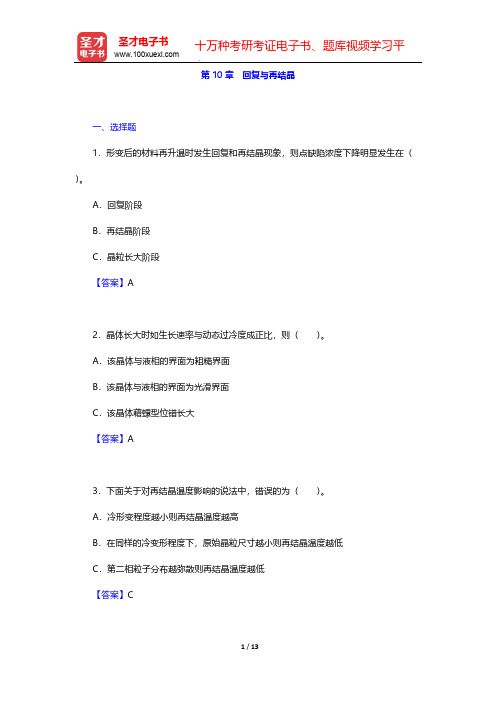
第10章 回复与再结晶一、选择题1.形变后的材料再升温时发生回复和再结晶现象,则点缺陷浓度下降明显发生在()。
A.回复阶段B.再结晶阶段C.晶粒长大阶段【答案】A2.晶体长大时如生长速率与动态过冷度成正比,则()。
A.该晶体与液相的界面为粗糙界面B.该晶体与液相的界面为光滑界面C.该晶体藉螺型位错长大【答案】A3.下面关于对再结晶温度影响的说法中,错误的为()。
A.冷形变程度越小则再结晶温度越高B.在同样的冷变形程度下,原始晶粒尺寸越小则再结晶温度越低C.第二相粒子分布越弥散则再结晶温度越低【答案】C4.下面关于回复与再结晶机制的差别中,正确的为()。
A.回复不需要孕育期,而再结晶需要孕育期B.回复不需要激活能,而再结晶需要激活能C.回复不能降低形变态的应变能,而再结晶将降低形变态的应变能【答案】A5.形变后的材料在低温回复阶段时其内部组织发生显著变化的是()。
A.点缺陷的明显下降B.形成亚晶界C.位错重新运动和分布【答案】A6.再结晶结束后发生晶粒长大时的驱动力主要来自()。
A.高的外加温度B.高的材料内部应变能C.高的总晶界能【答案】C二、填空题1.结晶过程中晶体界面向液相推移的方式被称为______,与液固界面的微观结构有关。
2.再结晶完成后,晶粒长大可分为______晶粒长大和______晶粒长大。
【答案】正常;异常三、名词解释1.回复答:回复是指经冷塑性变形的金属在加热时,在光学显微组织发生改变前(即在再结晶晶粒形成前)所产生的某些结构和性能的变化过程。
2.动态再结晶答:动态再结晶是指再结晶温度以上变形和再结晶同时进行的现象。
3.二次再结晶答:二次再结晶是再结晶结束后正常长大被抑制而发生的少数晶粒异常长大的现象。
四、简答题1.说明冷变形金属加热时回复、再结晶及晶粒长大的过程和特点。
答:(1)回复过程①组织不发生变化,仍保持变形伸长的晶粒形态。
③一般力学性能变化不大,硬度、强度仅稍有降低,塑性稍有提高;某些物理性能有较大变化,电阻率显著降低,密度增大。
无机材料科学基础答案第六,七,九,十章习题答案

6-1 略。
6-2 什么是吉布斯相律?它有什么实际意义?解:相律是吉布斯根据热力学原理得出的相平衡基本定律,又称吉布斯相律,用于描述达到相平衡时系统中自由度数与组分数和相数之间的关系。
一般形式的数学表达式为F=C-P+2。
其中F为自由度数,C 为组分数,P为相数,2代表温度和压力两个变量。
应用相率可以很方便地确定平衡体系的自由度数。
6-3 固体硫有两种晶型,即单斜硫、斜方硫,因此,硫系统可能有四个相,如果某人实验得到这四个相平衡共存,试判断这个实验有无问题?解:有问题,根据相律,F=C-P+2=1-P+2=3-P,系统平衡时,F=0 ,则P=3 ,硫系统只能是三相平衡系统。
图6-1 图6-26-4 如图6-1是钙长石(CaAl2Si2O)的单元系统相图,请根据相图回解:(1)六方、正交和三斜钙长石的熔点各是多少?(2)三斜和六方晶型的转变是可逆的还是不可逆的?你是如何判断出来的?(3)正交晶型是热力学稳定态?还是介稳态?解:(1)六方钙长石熔点约1300℃(B点),正钙长石熔点约1180℃(C点),三斜钙长石的熔点约为1750℃(A点)。
(2)三斜与六方晶型的转变是可逆的。
因为六方晶型加热到转变温度会转变成三斜晶型,而高温稳定的三斜晶型冷却到转变温度又会转变成六方晶型。
(3)正交晶型是介稳态。
6-5 图6-2是具有多晶转变的某物质的相图,其中DEF线是熔体的蒸发曲线。
KE是晶型I的升华曲线;GF是晶型II的升华曲线;JG是晶型III的升华曲线,回答下列问题:(1)在图中标明各相的相区,并写出图中各无变量点的相平衡关系;(2)系统中哪种晶型为稳定相?哪种晶型为介稳相?(3)各晶型之间的转变是可逆转变还是不可逆转变?解:(1)KEC为晶型Ⅰ的相区,EFBC 过冷液体的介稳区,AGFB晶型Ⅱ的介稳区,JGA晶型Ⅲ的介稳区,CED是液相区,KED是气相区;(2)晶型Ⅰ为稳定相,晶型Ⅱ、Ⅲ为介稳相;因为晶型Ⅱ、Ⅲ的蒸汽压高于晶型Ⅰ的,即它们的自由能较高,有自发转变为自由能较低的晶型Ⅰ的趋势;(3)晶型Ⅰ转变为晶型Ⅱ、Ⅲ是单向的,不可逆的,多晶转变点的温度高于两种晶型的熔点;晶型Ⅱ、Ⅲ之间的转变是可逆的,双向的,多晶转变点温度低于Ⅱ、Ⅲ的熔点。
材料科学基础课后习题答案
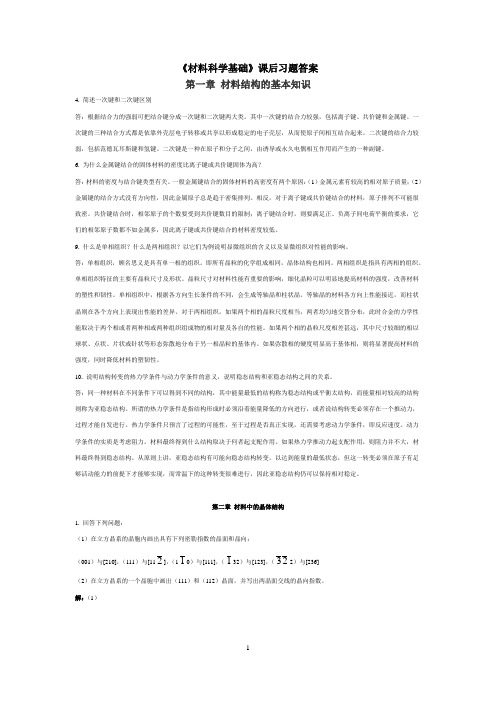
《材料科学基础》课后习题答案第一章材料结构的基本知识4. 简述一次键和二次键区别答:根据结合力的强弱可把结合键分成一次键和二次键两大类。
其中一次键的结合力较强,包括离子键、共价键和金属键。
一次键的三种结合方式都是依靠外壳层电子转移或共享以形成稳定的电子壳层,从而使原子间相互结合起来。
二次键的结合力较弱,包括范德瓦耳斯键和氢键。
二次键是一种在原子和分子之间,由诱导或永久电偶相互作用而产生的一种副键。
6. 为什么金属键结合的固体材料的密度比离子键或共价键固体为高?答:材料的密度与结合键类型有关。
一般金属键结合的固体材料的高密度有两个原因:(1)金属元素有较高的相对原子质量;(2)金属键的结合方式没有方向性,因此金属原子总是趋于密集排列。
相反,对于离子键或共价键结合的材料,原子排列不可能很致密。
共价键结合时,相邻原子的个数要受到共价键数目的限制;离子键结合时,则要满足正、负离子间电荷平衡的要求,它们的相邻原子数都不如金属多,因此离子键或共价键结合的材料密度较低。
9. 什么是单相组织?什么是两相组织?以它们为例说明显微组织的含义以及显微组织对性能的影响。
答:单相组织,顾名思义是具有单一相的组织。
即所有晶粒的化学组成相同,晶体结构也相同。
两相组织是指具有两相的组织。
单相组织特征的主要有晶粒尺寸及形状。
晶粒尺寸对材料性能有重要的影响,细化晶粒可以明显地提高材料的强度,改善材料的塑性和韧性。
单相组织中,根据各方向生长条件的不同,会生成等轴晶和柱状晶。
等轴晶的材料各方向上性能接近,而柱状晶则在各个方向上表现出性能的差异。
对于两相组织,如果两个相的晶粒尺度相当,两者均匀地交替分布,此时合金的力学性能取决于两个相或者两种相或两种组织组成物的相对量及各自的性能。
如果两个相的晶粒尺度相差甚远,其中尺寸较细的相以球状、点状、片状或针状等形态弥散地分布于另一相晶粒的基体内。
如果弥散相的硬度明显高于基体相,则将显著提高材料的强度,同时降低材料的塑韧性。
潘金生《材料科学基础》(修订版)(名校考研真题 凝固与结晶)【圣才出品】
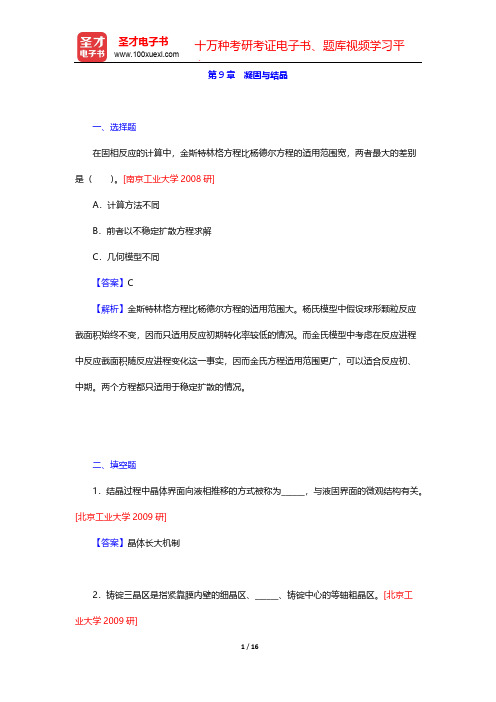
第9章 凝固与结晶一、选择题在固相反应的计算中,金斯特林格方程比杨德尔方程的适用范围宽,两者最大的差别是()。
[南京工业大学2008研]A.计算方法不同B.前者以不稳定扩散方程求解C.几何模型不同【答案】C【解析】金斯特林格方程比杨德尔方程的适用范围大。
杨氏模型中假设球形颗粒反应截面积始终不变,因而只适用反应初期转化率较低的情况。
而金氏模型中考虑在反应进程中反应截面积随反应进程变化这一事实,因而金氏方程适用范围更广,可以适合反应初、中期。
两个方程都只适用于稳定扩散的情况。
二、填空题1.结晶过程中晶体界面向液相推移的方式被称为______,与液固界面的微观结构有关。
[北京工业大学2009研]【答案】晶体长大机制2.铸锭三晶区是指紧靠膜内壁的细晶区、______、铸锭中心的等轴粗晶区。
[北京工业大学2009研]【答案】垂直膜壁生长的柱状晶区【解析】铸锭三晶区的最外层是细晶区,特点是该晶区厚度薄,晶粒细小;中间层是柱状晶区,特点是该晶区的性能有方向性,组织致密;最内层是等轴粗晶区,特点是该晶区的性能没有方向性,组织不够致密。
三、判断题1.对于相同的体系,非均匀成核位垒≤均匀成核位垒。
[中南大学2004研]【答案】√2.晶粒长大过程中,大角度晶界具有比较快的迁移速度。
()[北京工业大学2009研]【答案】√【解析】晶界迁移是指晶界两边物质的吉布斯自由能之差使界面向曲率中心移动的一种现象。
晶粒长大并不是小晶粒的相互黏结,而是晶界移动的结果。
晶界移动的速率与晶界曲率以及系统的温度有关。
温度升高和曲率半径越小,晶界向其曲率中心移动的速率也越快。
3.固态相变中,由于母相中存在大量晶体缺陷,使得相变过程中很难发生均匀形核。
()[北京工业大学2009研]【答案】√4.在固相不扩散、液相完全混合的条件下,固溶体凝固中不可能出现成分过冷。
()[西安交通大学2006研]【答案】√四、名词解释1.均匀成核[南京工业大学2008研]答:均匀成核是指晶核从均匀的单相熔体中产生的几率处处相同。
材料科学基础课后习题答案

材料科学基础课后习题答案第一篇:材料科学基础课后习题答案第1章习题1-10 纯铁点阵常数0.286nm,体心立方结构,求1cm3中有多少铁原子。
解:体心立方结构单胞拥有两个原子,单胞的体积为V=(0.286×10-8)3 cm3,所以1cm3中铁原子的数目为nFe= 122⨯2=8.55⨯10(2.86⨯10-8)31-11 一个位错环能否各部分都是螺型位错,能否各部分都是刃型位错?为什么?解:螺型位错的柏氏矢量与位错线平行,一根位错只有一个柏氏矢量,而一个位错环不可能与一个方向处处平行,所以一个位错环不能各部分都是螺型位错。
刃位错的柏氏矢量与位错线垂直,如果柏氏矢量垂直位错环所在的平面,则位错环处处都是刃型位错。
这种位错的滑移面是位错环与柏氏矢量方向组成的棱柱面,这种位错又称棱柱位错。
1-15 有一正方形位错线,其柏氏矢量及位错线的方向如图1-51所示。
试指出图中各段位错线的性质,并指出刃型位错额外串原子面所处的位置。
D CA B解:由柏氏矢量与位错线的关系可以知道,DC是右螺型位错,BA是左螺型位错。
由右手法则,CB为正刃型位错,多余半原子面在纸面上方。
AD为负刃型位错,多余半原子面在纸面下方。
第二篇:会计学基础课后习题答案《会计学基础》(第五版)课后练习题答案第四章习题一1、借:银行存款400 000贷:实收资本——A企业400 0002、借:固定资产400 000贷:实收资本——B企业304 000资本公积——资本溢价0003、借:银行存款000贷:短期借款0004、借:短期借款000应付利息(不是财务费用,财务费用之前已经记过)000贷:银行存款0005、借:银行存款400 000贷:长期借款400 0006、借:长期借款000应付利息000贷:银行存款000习题二1、4月5日购入A材料的实际单位成本=(53 000+900)/980=55(元/公斤)4月10日购入A材料的实际单位成本=(89 000+1 000)/1 500=60(元)2、本月发出A材料的实际成本=(600×50+600×55)+(380×55+1 020×60)=63 000+82 100=145 100(元)3、月末结存A材料的实际成本=(600×50)+[(53 000+900)+(89 000+1 000)]-145 100=28 800(元)习题三1、借:生产成本——A产品000——B产品000贷:原材料——甲材料000——乙材料0002、借:生产成本——A产品000 ——B产品000制造费用000贷:应付职工薪酬0003、借:制造费用500贷:原材料——丙材料5004、借:制造费用000贷:银行存款0005、借:制造费用000贷:累计折旧0006、本月发生的制造费用总额=5 000+500+2 000+1 000=8 500(元)制造费用分配率=8 500/(20 000+10 000)×100%=28.33%A产品应负担的制造费用=20 000×28.33%=5 666(元)B产品应负担的制造费用=8 500-5 666=2 834(元)借:生产成本——A产品——B产品贷:制造费用7、借:库存商品——A产品贷:生产成本——A产品习题四1、借:银行存款贷:主营业务收入2、借:应收账款——Z公司贷:主营业务收入银行存款3、借:主营业务成本贷:库存商品——A产品——B产品4、借:营业税金及附加贷:应交税费——应交消费税5、借:营业税金及附加贷:应交税费6、借:销售费用贷:银行存款7、借:销售费用贷:银行存款8、借:银行存款贷:其他业务收入借:其他业务成本贷:原材料——乙材料9、借:管理费用贷:应付职工薪酬10、借:管理费用贷:累计折旧11、借:管理费用贷:库存现金12、借:财务费用贷:银行存款13、借:银行存款贷:营业外收入14、借:主营业务收入其他业务收入营业外收入666 2 834 500 47 666 47 666 80 000 80 000 201 000200 000 000 142 680 42 680000 14 000 14 000 1 400 400 3 000 000 1 000 000 4 000 000 3 000 000 4 560 560 2 000 000300300400400 3 000 000 280 000 4 000 3 000贷:本年利润287 000借:本年利润172 340贷:主营业务成本680其他业务成本000营业税金及附加400销售费用000管理费用860财务费用400 本月实现的利润总额=287 000-172 340=114 660(元)本月应交所得税=114 660×25%=28 665(元)本月实现净利润=114 660-28 665=85 995(元)习题五1、借:所得税费用贷:应交税费——应交所得税借:本年利润贷:所得税费用2、2007的净利润=6 000 000-1 500 000=4 500 000(元)借:本年利润贷:利润分配——未分配利润3、借:利润分配——提取法定盈余公积贷:盈余公积——法定盈余公积4、借:利润分配——应付现金股利贷:应付股利第五章习题一1、借:银行存款固定资产贷:实收资本——M公司——N公司2、借:原材料——A材料——B材料贷:银行存款3、借:应付账款——丙公司贷:银行存款4、借:银行存款贷:短期借款5、借:固定资产贷:银行存款6、借:生产成本——甲产品——乙产品贷:原材料——A材料——B材料 500 000500 000 1 500 000500 000 4 500 000 4 500 000450 000450 000 1 000 000 1 000 000 1 000 000 1 000 000 1 000 000 1 000 000 50 000 50 000000 50 000 50 000500 000500 000200 000200 000000 80 000000 80 0007、借:其他应收款——王军000贷:库存现金0008、借:制造费用000管理费用贷:原材料——A材料0009、借:管理费用500贷:库存现金50010、借:原材料——A材料000贷:应付账款00011、借:应付职工薪酬200 000贷:银行存款200 00012、借:银行存款320 000贷:主营业务收入——甲产品320 00013、借:应收账款250 000贷:主营业务收入——乙产品250 00014、借:短期借款200 000应付利息000财务费用000贷:银行存款209 00015、借:销售费用贷:银行存款00016、借:管理费用300贷:其他应收款——王军000库存现金30017、借:生产成本——甲产品000——乙产品000制造费用000管理费用000贷:应付职工薪酬200 00018、借:制造费用000管理费用000贷:累计折旧00019、借:生产成本——甲产品000——乙产品000制造费用000管理费用000贷:应付职工薪酬000 20、借:主营业务成本381 000贷:库存商品——甲产品196 000——乙产品185 00021、制造费用总额=5 000+10 000+35 000+1 000=51 000(元)制造费用分配率=51 000/(90 000+70 000)×100%=31.875% 甲产品应分配的制造费用=90 000×31.875%=28 687.5(元)乙产品应分配的制造费用=70 000×31.875%=22 312.5(元)借:生产成本——甲产品687.5——乙产品312.5贷:制造费用00022、甲产品的实际成本=120 000+150 000+90 000+9 000+28 687.5=397 687.5(元)借:库存商品——甲产品397 687.5贷:生产成本——甲产品397 687.523、借:主营业务收入——甲产品320 000——乙产品250 000贷:本年利润借:本年利润贷:主营业务成本管理费用销售费用财务费用24、本月利润总额=570 000-487 800=82 200(元)本月应交所得税=82 200×25%=20 550(元)借:所得税费用贷:应交税费——应交所得税借:本年利润贷:所得税费用25、本月净利润=82 200-20 550=61 650(元)提取法定盈余公积=61 650×10%=6 165(元)借:利润分配——提取法定盈余公积贷:盈余公积——法定盈余公积26、借:利润分配——应付现金股利贷:应付股利570 000 487 800381 000 53 800 50 000 000 20 550 20 550 20 550 20 550 6 165 165 30 825 30 825第三篇:《机械设计基础》课后习题答案模块八一、填空1、带传动的失效形式有打滑和疲劳破坏。
潘金生《材料科学基础》(修订版)(章节题库 相 图)【圣才出品】
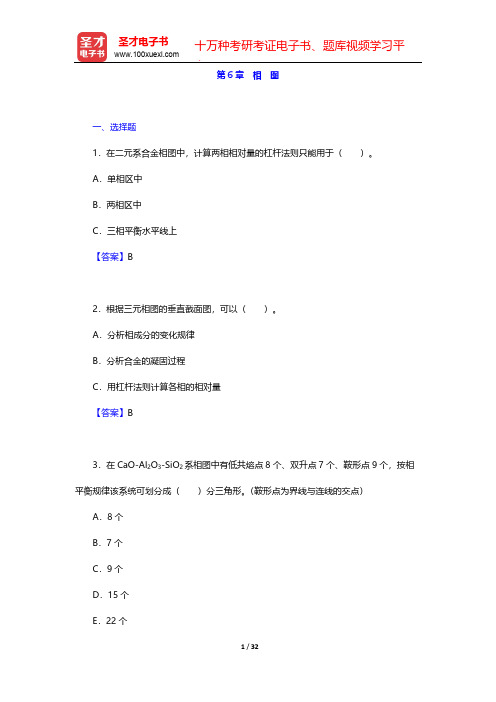
第6章 相 图一、选择题1.在二元系合金相图中,计算两相相对量的杠杆法则只能用于()。
A.单相区中B.两相区中C.三相平衡水平线上【答案】B2.根据三元相图的垂直截面图,可以()。
A.分析相成分的变化规律B.分析合金的凝固过程C.用杠杆法则计算各相的相对量【答案】B3.在CaO-Al2O3-SiO2系相图中有低共熔点8个、双升点7个、鞍形点9个,按相平衡规律该系统可划分成()分三角形。
(鞍形点为界线与连线的交点)A.8个B.7个C.9个D.15个E.22个二、填空题图6-1是A-B-C三元系成分三角形的一部分,其中X合金的成分是______。
图6-1【答案】20%A-40%B-40%C三、判断题相图表示的是体系的热力学平衡状态。
()【答案】√【解析】相图狭义上是用来表示相平衡系统的组成与一些参数(如温度、压力)之间关系的一种图;广义上是指在给定条件下体系中各相之间建立平衡后热力学变量强度变量的轨迹的集合表达。
相图表达的是平衡态,严格说是相平衡图。
1.结线答:结线是指两平衡相成分点之间的连线。
2.相图答:相图是描述各相平衡存在条件或共存关系的图解;也可称为平衡时热力学参量的几何轨迹。
五、简答题1.图6-2为Fe-W-C三元系的液相面投影图。
写出1700℃、1200℃、1085℃的四相平衡反应式。
选择一个合金成分其组织在刚凝固完毕时只有三元共晶。
图6-2答:(1)各四相平衡反应式分别为:1700℃:L+WC+W→η;1200℃:L +η→WC+γ;1085℃:L→γ+WC +Fe 3C 。
(2)Ⅰ合金成分其组织在刚凝固完毕时只有三元共晶。
2.请在图6-3所示的Pb-Bi-Sn 相图中:(1)写出三相平衡和四相平衡反应式;(2)标出成分为5%Pb、65%Bi 与30%Sn 合金所在位置,写出该合金凝固结晶过程,画出并说明其在室温下的组织示意图。
图6-3答:(1)三相平衡反应式:E 2E 线:L→Bi+Sn ;E 1E 线:L→Bi+Pb ;E 点为四相平衡,其反应式为L→Bi+Sn +Pb 。
潘金生材料科学基础(修订版)知识点笔记课后答案

第1章晶体学基础1.1复习笔记一、空间点阵1.晶体特征和空间点阵概述(1)晶体特征晶体的一个基本特征是具有周期性。
(2)空间点阵空间点阵是指用来描述晶体中原子或原子集团排列的周期性规律的在空间有规律分布的几何点的集合。
2.晶胞、晶系和点阵类型(1)晶胞①晶胞的定义空间点阵可以看成是由最小的单元——平行六面体沿三维方向重复堆积(或平移)而成。
这样的平行六面体称为晶胞。
②点阵常数a.描述晶胞的大小:三条棱的长度a,b和c;b.描述晶胞的形状:棱之间的夹角α,β和γ。
③选取晶胞的条件a.能反映点阵的周期性;b.能反映点阵的对称性;c.晶胞的体积最小。
(2)晶系按照晶胞的大小和形状的特点,或按照6个点阵常数之间的关系和特点,可以将各种晶体归为7种晶系。
表1-1 7种晶系(3)点阵类型①简单三斜点阵(如图1-1(1)所示);②简单单斜点阵(如图1-1(2)所示);③底心单斜点阵(如图1-1(3)所示);④简单斜方点阵(如图1-1(4)所示);⑤底心斜方点阵(如图1-1(5)所示);⑥体心斜方点阵(如图1-1(6)所示);⑦面心斜方点阵(如图1-1(7)所示);⑧六方点阵(如图1-1(8)所示);⑨菱方点阵(三角点阵)(如图1-1(9)所示);⑩简单正方(或四方)点阵(如图1-1(10)所示);⑪体心正方(或四方)点阵(如图1-1(11)所示);⑫简单立方点阵(如图1-1(12)所示);⑬体心立方点阵(如图1-1(13)所示);⑭面心立方点阵(如图1-1(14)所示)。
图1-1 14种空间点阵(4)布拉维点阵与复式点阵①布拉维点阵:由等同点构成的点阵;②复式点阵:由几个布拉维点阵穿插而成的复杂点阵。
二、晶面指数和晶向指数1.晶面指数和晶向指数(1)晶面指数将截距的倒数化成三个互质的整数h,k,l,则(hkl)称为待标晶面的晶面指数。
(2)晶向指数将晶向上除原点以外的任一点的坐标x,y,z化成互质整数u,v,w,得到晶向指数[uvw]。
《材料科学基础》各章习题

图2-1 第一章 金属的晶体结构1. 试证明四方晶系中只有简单四方和体心四方两种点阵类型。
2. 为什么密排六方结构不能称作为一种空间点阵?3. 标出面心立方晶胞中(111)面上各点的坐标,并判断]101[是否位于(111)面上,然后计算]101[方向上的线密度。
4. 标出具有下列密勒指数的晶面和晶向:a) 立方晶系)421(,)231(,)130(,[]112,[]311;b) 六方晶系 )1112(,)0111(,)2123(,]1112[,]1321[。
5. 在立方晶系中画出{}111晶面族的所有晶面,并写出{123}晶面族和﹤221﹥晶向族中的全部等价晶面和晶向的密勒指数。
6. 在立方晶系中画出以]001[为晶带轴的所有晶面。
7. 试证明在立方晶系中,具有相同指数的晶向和晶面必定相互垂直。
8. 已知纯钛有两种同素异构体,低温稳定的密排六方结构Ti -α和高温稳定的体心立方结构Ti -β,其同素异构转变温度为882.5℃,计算纯钛在室温(20℃)和900℃时晶体中(112)和(001)的晶面间距(已知a a 20℃=0.2951nm, c a 20℃=0.4679nm, a β900℃=0.3307nm )。
9. 试计算面心立方晶体的(100),(110),(111)等晶面的面间距和面致密度,并指出面间距最大的面。
10. 平面A 在极射赤平面投影图中为通过NS 极和点0°N ,20°E 的大圆,平面B 的极点在30°N ,50°W处,a)求极射投影图上两极点A 、B 间的夹角;b)求出A绕B 顺时针转过40°的位置。
11. a)说明在fcc 的(001)标准极射赤面投影图的外圆上,赤道线上和0°经线上的极点的指数各有何特点?b)在上述极图上标出)101(、)011(、)112(极点。
12. 由标准的(001)极射赤面投影图指出在立方晶体中属于[110]晶带轴的晶带,除了已在图2-1中标出晶面外,在下列晶面中那些属于[110]晶带?)212(),231(),131(),210(),211(。
《材料科学基础》习题及参考答案
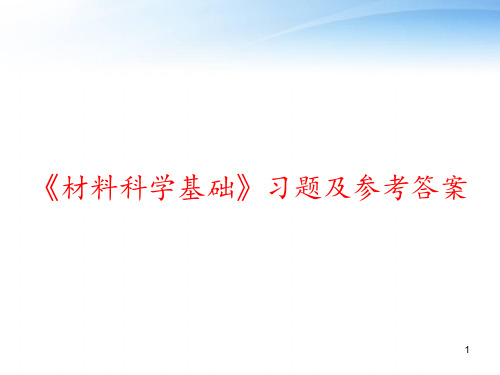
形核功,还是可以成核的。
答案
(7)测定某纯金属铸件结晶时的最大过冷度,其实测
值与用公式ΔT=0.2Tm计算值基本一致。
答案
(8) 某些铸件结晶时,由于冷却较快,均匀形核率N1
提高,非均匀形核率N2也提高,故总的形核率为N=
N1 +N2。
答案
返回
53
(9) 若在过冷液体中,外加10 000颗形核剂,则结晶
❖ ②比较Cu-10% Sn合金铸件和Cu-30%合金铸件的铸造性能 及铸造组织,说明Cu-10% Sn合金铸件中有许多分散砂眼的 原因。
③ω(Sn}分别为2%,11%和15%的青铜合金,哪一种可进行 压力加工?哪种可利用铸造法来制造机件?
答案
返7回8
❖ 9.如下图所示,已知A,B,C三组元固态完全不互溶,质量 分数分别84%A,,10%B,10%C的O合金在冷却过程中将进 行二元共晶反应和三元共晶反应,在二元共晶反应开始时, 该合金液相成分(a点)为60%A,20%B,20%C,而三元共 晶反应开始时的液相成分(E点)为50%A,10%B,40%C。
答案
返回
6
❖ 6.位错受力后运动方向处处垂直于位错线,在运动
过程中是可变的,晶体作相对滑动的方向应是什么
方向?
答案
❖ 7.位错线上的割阶一般如何形成?
答案
❖ 8.界面能最低的界面是什么界面?
答案
❖ 9. “小角度晶界都是由刃型位错排成墙而构成的”这
种说法对吗?
答案
返回
7
三、综合题
❖ 1. 作图表示立方晶体的(123)(0 -1 -2) (421)晶面及[-102][-211][346]晶向。 答案
❖ 9. 在Fe中形成1mol 空位的能量为104. 67kJ,
潘金生《材料科学基础》(修订版)(章节题库 凝固与结晶)【圣才出品】

第9章 凝固与结晶一、选择题1.凝固时在形核阶段,只有核胚半径等于或大于临界尺寸时才能成为结晶的核心。
当形成的核胚其半径等于临界尺寸时,体系的自由能变化()。
A.大于零B.等于零C.小于零【答案】A2.晶体凝固时若以均匀形核方式进行,则当形成临界晶核时()。
A.升高B.降低C.不变【答案】A3.铸锭凝固时如大部分结晶潜热可通过液相散失时,则固态显微组织主要为()。
A.树枝晶B.柱状晶C.球晶【答案】A4.凝固时不能有效降低晶粒尺寸的是以下哪种方法?()A.加入形核剂B.减小液相的过冷度C.对液相实施搅拌【答案】B5.合金在凝固时产生成分过冷的条件是()。
(其中T L是成分为C L的合金开始凝固温度)A.B.C.【答案】A二、填空题1.典型铸锭组织通常有______、______和______。
【答案】表层细晶区;柱状晶区;中心等轴晶区2.区域提纯依据的原理是______。
【答案】固溶体定向凝固时溶质再分布(选分结晶)三、名词解释1.均匀成核答:均匀成核是指晶核从均匀的单相熔体中产生的几率处处相同的成核方式。
2.成分过冷答:成分过冷是指结晶时由于固相和液相成分的再分布而引起的固-液界面前方附近液相中产生过冷区的现象。
3.同分凝固与异分凝固答:同分凝固与异分凝固:凝固时不发生成分变化的称同分凝固;反之,凝固时伴随成分变化,称异分凝固。
四、简答题1.相同过冷度下比较均匀形核与非均匀形核的临界半径、临界形核功、临界晶核体积,哪个大?答:临界半径相同;临界形核功是均匀形核时高;临界晶核体积也是均匀形核时大。
2.简述凝固过程的宏观特征,叙述凝固过程中晶体成长的机理。
答:(1)凝固时宏观特征:要有一定的过冷度,会放出明显的结晶潜热。
(2)成长机理有三种:连续式成长、二维形核及借助台阶侧向生长、借螺旋位错生长。
3.如图9-1所示相图,写出四相反应;分析2点合金结晶过程。
图9-1答:P点(包共晶反应):,E点(三元共晶):。
材料科学基础第九章答案

第九章答案9-2什么叫相变?按照相变机理来划分,可分为哪些相变?解:相变是物质系统不同相之间的相互转变。
按相变机理来分,可以分为扩散型相变和非扩散型相变和半扩散型相变。
依靠原子或离子长距离扩散进行的相变叫扩散型相变。
非扩散型型相变指原子或离子发生移动,但相对位移不超过原子间距。
9-3分析发生固态相变时组分及过冷度变化相变驱动力的影响。
解:相变驱动力是在相变温度下新旧相的体自由能之差(),而且是新相形成的必要条件。
当两个组元混合形成固溶体时,混合后的体系的自由能会发生变化。
可以通过自由能-成分曲线来确定其相变驱动力的大小。
过冷度是相变临界温度与实际转变温度之差,相变形核的热力学条件是要有过冷度。
已知驱动力与过冷度之间的关系是:,这进一步说明了形核的热力学条件。
9-4马氏体相变具有什么特征?它和成核-生成相变有何差别?解:马氏体相变是替换原子经无扩散切变位移(均匀或不均匀)并由此产生形状改变和表面浮凸、曾不变平面应变特征的一级形核、长大的相变。
特征:具有剪切均匀整齐性、不发生原子扩散、相变速度快、相变有一定范围、有很大的切变型弹性应变能。
成核-生长过程中存在扩散相变,母相与晶相组成可相同可不同,转变速度较慢,无明显的开始和终了温度。
9-5试分析应变能及表面能对固态相变热力学、动力学及新相形状的影响。
解:物质的表面具有表面张力σ,在恒温恒压下可逆地增大表面积dA,则需功σdA,因为所需的功等于物系自由能的增加,且这一增加是由于物系的表面积增大所致,故称为表面自由能或表面能。
应变能和表面能可以影响相变驱动力的大小,和新相的形状。
9-6请分析温度对相变热力学及动力学的影响。
解:当温度降低,过冷度增大,成核势垒下降,成核速率增大,直至达到最大值;当温度继续下降,液相粘度增加,原子或分子扩散速率下降。
温度过高或过低对成核和生长速率均不利,只有在一定的温度下才有最大成核和生长速率。
9-7调幅分解与脱溶分解有何异同点?调幅分解所得到的显微结构与性能有何特点?解:调幅分解通过扩散偏聚由一种固溶体分解成与母相结构相同而成分不同的两种固溶体。
《材料科学基础》课后习题及参考答案
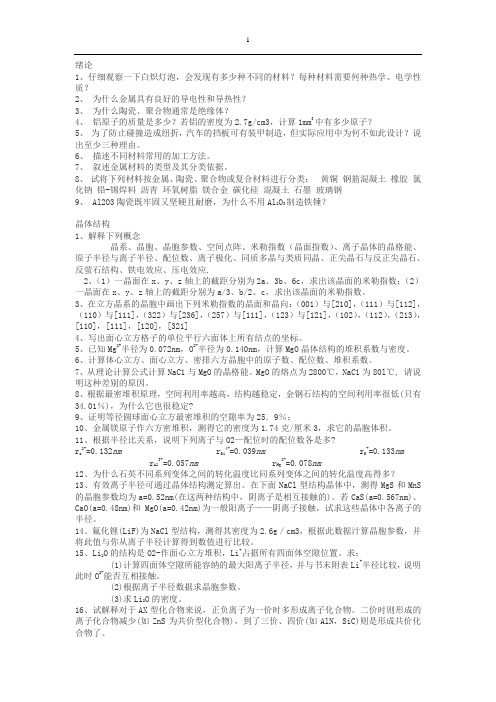
绪论1、仔细观察一下白炽灯泡,会发现有多少种不同的材料?每种材料需要何种热学、电学性质?2、为什么金属具有良好的导电性和导热性?3、为什么陶瓷、聚合物通常是绝缘体?4、铝原子的质量是多少?若铝的密度为2.7g/cm3,计算1mm3中有多少原子?5、为了防止碰撞造成纽折,汽车的挡板可有装甲制造,但实际应用中为何不如此设计?说出至少三种理由。
6、描述不同材料常用的加工方法。
7、叙述金属材料的类型及其分类依据。
8、试将下列材料按金属、陶瓷、聚合物或复合材料进行分类:黄铜钢筋混凝土橡胶氯化钠铅-锡焊料沥青环氧树脂镁合金碳化硅混凝土石墨玻璃钢9、 Al2O3陶瓷既牢固又坚硬且耐磨,为什么不用Al2O3制造铁锤?晶体结构1、解释下列概念晶系、晶胞、晶胞参数、空间点阵、米勒指数(晶面指数)、离子晶体的晶格能、原子半径与离子半径、配位数、离子极化、同质多晶与类质同晶、正尖晶石与反正尖晶石、反萤石结构、铁电效应、压电效应.2、(1)一晶面在x、y、z轴上的截距分别为2a、3b、6c,求出该晶面的米勒指数;(2)一晶面在x、y、z轴上的截距分别为a/3、b/2、c,求出该晶面的米勒指数。
3、在立方晶系的晶胞中画出下列米勒指数的晶面和晶向:(001)与[210],(111)与[112],(110)与[111],(322)与[236],(257)与[111],(123)与[121],(102),(112),(213),[110],[111],[120],[321]4、写出面心立方格子的单位平行六面体上所有结点的坐标。
5、已知Mg2+半径为0.072nm,O2-半径为0.140nm,计算MgO晶体结构的堆积系数与密度。
6、计算体心立方、面心立方、密排六方晶胞中的原子数、配位数、堆积系数。
7、从理论计算公式计算NaC1与MgO的晶格能。
MgO的熔点为2800℃,NaC1为80l℃, 请说明这种差别的原因。
8、根据最密堆积原理,空间利用率越高,结构越稳定,金钢石结构的空间利用率很低(只有34.01%),为什么它也很稳定?9、证明等径圆球面心立方最密堆积的空隙率为25.9%;10、金属镁原子作六方密堆积,测得它的密度为1.74克/厘米3,求它的晶胞体积。
潘金生《材料科学基础》(修订版)(章节题库 晶体学基础)【圣才出品】
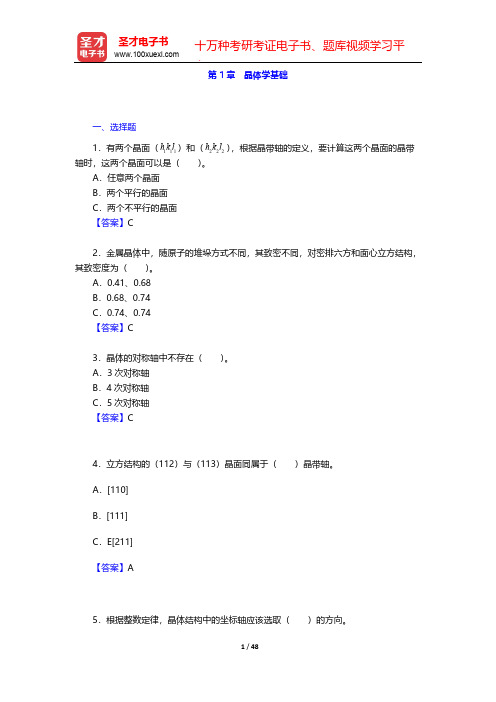
10.氯化铯( )为有序体心立方结构,它属于( )。 A.体心立方点阵 B.面心立方点阵 C.简单立方点阵 【答案】C
11.六方晶系中( )晶面间距( )( )晶面间距。 A.小于 B.等于 C.大于 【答案】A
12.立方晶体中的[001]方向是( )。 A.二次对称轴 B.四次对称轴 C.六次对称轴
子数目是 3~4;③氧多面体相互共顶连接且至少有三个顶角与相邻多面体共用 【答案】C
15.晶体的晶面指的是( )。 A.描述晶体是选取的晶系坐标轴所构成的平面 B.与晶系坐标轴成特殊夹角的平面 C.原子所构成的平面 【答案】C
16.在晶系坐标轴上分别取 a/2、b/3、c/4 三个点,连接这三个点得到的平面,其晶 面指数为( )。
18.金属晶体中最典型的结构是( )。 A.面心立方、体系立方、密排六方 B.面心立方、简单立方、密排六方 C.面心立方、体系四方、密排六方 【答案】A
19.描述晶体的间隙时通常可用 rA /rB 表示,其中( )。 A. rA 表示堆积原子的半径, rB 表示形成间隙多面体的两个原子间的距离 B. rA 表示堆积原子的半径, rB 表示形成间隙多面体的两个原子间的距离的一半 C. rA 表示堆积原子的半径, rB 表示形成多面体间隙中可放入最大原子的半径 【答案】C
8.在面心立方晶体结构中,密排面( )。 A.{001}面 B.{011}面 C.{111}面
2 / 48
圣才电子书
【答案】C
十万种考研考证电子书、题库视频学习平 台
9.晶胞可以描述为( )。 A.任意在晶体中选取的平行六面体 B.点阵中取出的一个具有相同阵点数的代表性基本单元 C.点阵中取出的一个反映点阵对称性的代表性单元 【答案】C
材料科学基础课后习题答案9
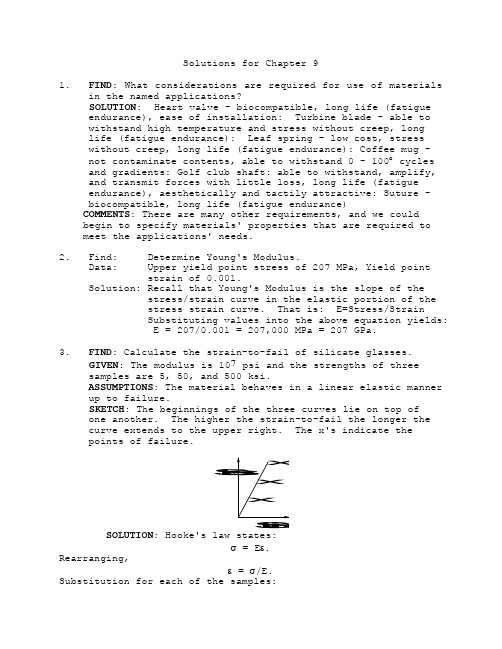
Solutions for Chapter 91. FIND: What considerations are required for use of materialsin the named applications?SOLUTION: Heart valve - biocompatible, long life (fatigueendurance), ease of installation: Turbine blade - able towithstand high temperature and stress without creep, longlife (fatigue endurance): Leaf spring - low cost, stresswithout creep, long life (fatigue endurance): Coffee mug -not contaminate contents, able to withstand 0 - 100︒ cyclesand gradients: Golf club shaft: able to withstand, amplify,and transmit forces with little loss, long life (fatigueendurance), aesthetically and tactily attractive: Suture -biocompatible, long life (fatigue endurance)COMMENTS: There are many other requirements, and we couldbegin to specify materials' properties that are required tomeet the applications' needs.2. Find: Determine Young's Modulus.Data: Upper yield point stress of 207 MPa, Yield pointstrain of 0.001.Solution: Recall that Young's Modulus is the slope of thestress/strain curve in the elastic portion of thestress strain curve. That is: E=Stress/StrainSubstituting values into the above equation yields:E = 207/0.001 = 207,000 MPa = 207 GPa.3. FIND: Calculate the strain-to-fail of silicate glasses.GIVEN: The modulus is 107 psi and the strengths of threesamples are 5, 50, and 500 ksi.ASSUMPTIONS: The material behaves in a linear elastic manner up to failure.SKETCH: The beginnings of the three curves lie on top ofone another. The higher the strain-to-fail the longer thecurve extends to the upper right. The x's indicate thepoints of failure.tiSanrtSOLUTION: Hooke's law states:σ = Eε.Rearranging,ε = σ/E.Substitution for each of the samples:ε = 5000 psi / 107 psi = 0.05%ε = 50,000 psi / 107 psi = 0.5%ε = 500,000 psi / 107 psi = 5%.COMMENTS: The smallest value represents that of ordinary window glass. The largest value is characteristic of an optical fiber.4. Find: Determine if the stress is above or below theyield stress. If the stress is below the yield stresscompute Young's Modulus.Data: The yield stress for the mild steel is 207 MPa. A specimen has a diameter of 0.01m and a length of0.1m. It is loaded in tension to 1000N anddeflects 6.077 x 10-6m.Solution: To solve this problem, we must first determine the applied tensile stress. Recall that the tensilestress is given by the formula: Stress=Force(P)/Area Normal to force (A). The cross sectionalarea is: A= πD2/4 = 3.1416x(0.01)2/4 = 7.85x10-5The stress is: Stress = 1000/7.85x10-5 = 12.7MPaThe applied stress is much less than the yieldstress. To obtain the Modulus recall thedefinition: E=σ/ε. We must thus compute thestrain in order to determine the Modulus:ε=∆l/l o = 6.077x10-6/0.1 = 6.077x10-5Thus E=12.7/6.077x10-5 = 2.09x105 MPa.5. Find: Compute deflection of specimens.Data: E Al=70,460MPa, E Cu=122,500MPa, E W=388,080MPa,A=0.01m x 0.01m=10-4m2, Length(l o)=1m,Load(P)=5000N.Solution: Start with the relationship between stress andstrain for linear elastic behavior: σ=Eε (1)Note that: σ=P/A (2)ε=∆l/l o (3)Substitute (2) & (3) into (1): Thus P/A=E∆l/l o (4)Rearranging to solve for ∆l we have:∆l=Pl o/AE=5000 x 1/(10-4E)=5x107/E (5)Note that for ∆l to be in meters we require E tobe expressed in Pa. Using (5) and E in Pa we getthe following deflection values:Al=7.09x10-4m, Cu=4.08x10-4m, W=1.29x10-4m.6. Find: Deflection at 5000N.Data: E Nylon6/6=2.08GPa, Load(P)=5000N, l o=1m, A=10-4m2.Solution: Using the formula developed in the precedingproblem we have: ∆l o=Pl o/(AE).Thus: ∆l o=(5000 x 1)/(10-4x2.08x109)=2.4x10-2m.Comment: Note that the deflection is two orders ofmagnitude greater than for steels.7. FIND: Calculate the strength of a round textile fiber.GIVEN: The fiber diameter is 10 micrometers and the load-at-failure is 25 g.ASSUMPTIONS: The fiber need not be in the elastic region at failure.SOLUTION:σ = F/A = 002598510262../sec()kg mx m⨯-π= 3.1 GPa.8. Find: Determine the shear strain at yield.Data: For a particular steel: ν=0.295, E = 205,000MPa,σys=300MPa and τys = 1/2σys.Solution: Recall Hooke's Law in shear: τys= Gγys. Also, itis stated that τys = 1/2σys. Substitution yields:1/2σys = Gγys or γys= σys/2G. The problem now is todetermine G. Recall that G=E/(2(1+ν))=205,000/(2(1+0.295))=79,151 MPa. Substituting wehave: γys= 300/(2x79,151)=1.895x10-3.9. Find: Compute the 0.2% offset yield strength and thestrain at yield.Data: E Al=69x103 MPa and σ=295ε0.1.Solution: We require the intersection point of the twocurves shown below to solve the problems since the0.2% offset yield is defined as the point where aline whose slope is equal to the modulus, andwhich is displaced 0.002 on the strain axis,intersects the stress/strain curve. To find theintersection point we must first get the equationfor 0.2% offset yield. The general form of theequation is: σ=mε + b, where m=slope andb=intercept. We know that the point (0.002,0) ison the line thus: 0=69x103(0.002) + b, thereforeb= -1.38x102. The equation of the 0.2% offsetline is σ = 69x103ε - 1.38x102. The intersectionis obtained by rearranging and substituting theformer equation with the first equation: 295ε0.1 =69x103ε-1.38x102. This equation is best solved bytrial and error or by writing a short computerprogram to check for the equality of the right andleft hand sides of the equation for various valuesof ε. At a strain of 0.00448 the differencebetween the right and left-hand sides of theequation is negligible. Substituting this strainvalue into the equation for stress yields anestimate for the yield stress of 172 MPa.10. Find: (a) Poisson's ratio, (b) % volume change at σys/2and (c) % volume change at σys.Data: Aluminum specimen with the following properties:E=69x103 MPa loaded such that εl = 1.25x10-3 and εv= 4.17x10-4 .Solution: (a) Recall that Poisson's ratio is defined as ν = -εv/εl. Thus, ν = -(-4.17x10-4 /1.25x10-3)=0.333.(b) The volume change is given by ∆v/v o=εx+εy+εz.But εy = εl, εx,εz = εv and εv =-νεl. Thus, ∆v/v o=εx +νεl +νεl= εl(1-2ν). In the preceding problem it wasshown that the yield strain was 4.48x10-3. Athalf the yield the strain is 2.24x10-3. Then∆v/v o = (2.24x10-3)(1-0.666) = (7.48x10-4)x100=7.48x10-2.(c) At yield stress: ∆v/v o x 100=4.48x10-3 x 0.334x 100 = 1.50 x 10-1.11. Find: Predict the behavior of amorphous polymers.Solution: Steels have a definite yield point becausedislocations are pinned by carbon atoms thatreside in the interstitial positions. When stressrises to the point necessary for dislocations tobreak free from the carbon atoms, plasticdeformation occurs due to dislocation movement.Yield stress is the critical stress necessary forfreeing the dislocations from the carbon atoms.In Al and Cu, that have an FCC structure,dislocation mobility increases gradually as thestress is increased. Therefore, there is nosingle stress level at which the dislocationsbegin to move suddenly. In these materials,yielding occurs gradually, dislocations motion maybe impeded, but the dislocations are not pinned.In amorphous polymers, plastic deformation occursby sliding between adjacent molecular chains. Thesliding will commence at a definite stress level.Therefore, we expect a definite yield point tooccur in amorphous polymers.12. Find: Determine the ultimate tensile strength.Data: The stress-strain behavior is given by σ = Kεn.Solution: Let engineering stress be designated by S andengineering strain by e. The following equationsrelate engineering stress and strain to truestress and true strain:σ = S(1+e) (1)and ε = ln(1+e) (2)We are given σ = Kεn (3)Substituting (1) and (2) into (3), we get: S(1+e)= K[ln(1+e)]n. At the ultimate tensile stresspoint, dS/de = 0. Thus, dS/de = (d/de) [[(K/(1+e)](lu(1+e))n] = 0, or - (K/(1+e)2][(ln(1+e))n]+[Kn/(1+e)2][(ln(1+e))n-1] = 0or ln(1+e) = n (3a)If we designate e by e u at the ultimate tensilepoint, σu = K[ln(1+e u)]n (4)Substituting equation (4) into (3) we get σu =K[ln(1+e u)]n, or S u(1+e u) = Kn n. Solving for S uyields: S u = [K/(1+e u)] n n = Kn n-1 (4a)S u is the ultimate tensile strength.Comment: Equation (3a) is frequently used to estimate n ifa complete stress-strain curve is not available.Further, equation (4a) can be used to obtain thestrength coefficient, K.13. Find: 1) The physical basis for the observation and 2)show ν=0.5 during plastic deformation.Data: Volume of a crystalline material remains constantduring plastics deformation.Solution: 1) During purely plastic deformation interatomicdistance is not changing and the atoms eventuallyslide over one another. for this reason thevolume is constant during plastic deformation.2) Recall that ∆ν/νo = εx + εy + εz = ε(1-2ν) foruniaxial deformation. If ∆ν = 0 , then ν=1/2.14. Find: Compute the relative load bearing capacities of anAl alloy (σUTS = 400 MPa, ρ = 2.7 gm/cm3 ) and polypropylene(σUTS = 40 MPa, ρ=0.9 gm/cm3 ).Data: Relative load capacity for constant weight isproportional to the strength divided by thedensity.Solution:To have consistent units, convert density to kg/m3.ρAl= 2.7x103 kg/m3ρPP= 0.9x103 kg/m3σAl'= 400x106/2.7x103(Pa/kg/m3)=148x103(Pa m3/kg)Recall Pa=N/m2, therefore σAl'= 148x103 (N m/kg)and σpp'=40x106/0.9x103=44.4x103 (N-m/kg).16. Find: Plot the true strain to fracture, being sure toplace Cu and steel from the preceeding problem in the graph.Data: A range of %RA from 0 to 70%.Solution: Recall that the true strain may be computed fromthe %RA using the formula: f = ln(100/(100-%RA)).See graph for correlation of fracture strainand %RA.17. Find: Determine the engineering strain at which thedifference between the true strain and the engineeringstrain is ε = ln (1+e).Data: Equation relating engineering strain to truestrain.Solution: We can write a series expansion for the right hand side:ε = ln (1+e) = e-(e2/2!)+(e3/3!)-(e4/4!)+... Forsmall values of e, we need to consider only thefirst two terms in the expansion: ε = e-(e2/2!).For 5% difference ε =0.95e, therefore (0.95e)-e=-e2 or 0.05=e. Then, for a strain up to 5%, thedifference between the true and engineering strainwill be equal to or less that 5%.18. Find: Explain why we report different lengths fordifferent materials.Solution: Polymer specimens do not have a tendency to form a necked region like metals do. Instead, polymerspecimens deform uniformly through the gage length.Therefore, the final percent elongation inpolymer specimens is not dependent on the gagelength like it is for metals, and the informationon gage length then becomes redundant.19. Find: Compare the glass transition temperatures.Solution: Glass transition temperatures can be increased bycross-linking which also influences the elasticmodulus without changing its molecular weight.Therefore, the polymer with a higher glasstransition temperature will also have a higherelastic modulus.20. Find: Relaxation modulus, E r(t), of the polymer.Data: σ(t) = σo exp(-t/τ)σo = 2 MPa for a sudden strain of 0.2σ(t) = 0.5 MPa at t = 50 secondsSolution: It must be assumed that the strain remainsconstant during the relaxation process. σ(t) = 2MPa for t = 0, or σ0 = 2 MPa. Substituting σ(t) =0.5 MPa at t = 50 s into the given equation, weget 0.5 = 2 exp(-50/τ). Solving for τ,τ = -50/[ln(0.5/2)] = 36.07 s.E r(t) = (σ(t)/εo) = [2 exp(-t/36.07)]/0.2 = 10exp(-t/36.07) = 10 exp(-10/36.07) = 7.58 MPa21. FIND: Show with a sketch how the modulus changes with timein a creep test.GIVEN: The test sample is a polymer. The load history of a creep test is as follows:emTiASSUMPTIONS: The load is insufficient to break the polymer.SKETCH:meiTSOLUTION: The equation for the modulus is given in equation 9.2-7, which states that E(t) = σo / ε(t). Since the material creeps, its length increases with time. Since the denominator increases and the numerator is constant, the modulus decreases.COMMENTS: Shown is a sample that creeps only to a limit.Many polymers behave in this fashion.22. Find: (a) Explain why normal the tensile test isused (b) differences in three of four point bendspecimens and (c) some limitations on data.Solution: (a) Due to the brittle nature of ceramics,there is a very significant risk of failureoutside the gage section of the specimen duringgripping. Also, such specimens are difficult andexpensive to machine.(b)The three or four point bend specimens aresubjected to negative (or compressive) loads anddo not require grips for loading. Hence, there isno risk of premature failure.(c)The stress distribution in a 3-point or 4-pointbend specimen is non-uniform along the cross-section of the specimen. Hence, the strength isobtained by calculating the outer fiber stress inthe specimen at the time of the failure. Thestrength values obtained from these tests haveconsiderable scatter.23. Find: Determine the load, P, at fracture.Data: Modulus of rupture, σ, = 3000 MPa, diameter, d, of the cylindrical specimen = 5mm and separationbetween support points, L = 25 mm.Solution: σ = PLd/4I, where I (bending moment of inertia) = πd4/64. Hence, σ = (PLd)64/(4πd4) = 16PL/(πd3),or P=(σπd3)/16L=[(3000x106N)π(.005)3]/[16(0.025)]P = 2945 Newtons.24. Find: Compute the diameter of an indentation for aBrinell hardness test using a standard indenter of 10mmdiameter.Given: The tensile strength is 800 MPa.Solution: To solve the problem we must first determine thehardness corresponding to a strength of 800 MPa.Using the graph in the text the Brinell hardness(BHN) is approximately 241. We next note theformula relating BHN to indentation diameter:BHN = 2P/(πD(D-(D2-d2)1/2)) where P = load (kg), D= indenter diameter (mm), d = diameter ofindentation (mm). Substituting the appropriatevalues yields 241=(6000/(10π(10-(100-d2)1/2))=191/(10-(100-d2)1/2). We can rearrange theequation such that: (100-d2)1/2 = [10-(191/241)] =9.208, or 100-d2 = 9.2082, thus, d2 = 100-9.2082=1.521, therefore d=3.90 mm.25. Find: Calculate the Brinell hardness as a function ofload for 1/4 hard and 1/2 hard brass.Data: Indentation diameter vs load for 1/4 hard and 1/2 hard brass.Solution: The Brinell Hardness Number is obtained from thefollowing equation:BHN=Load/Indentation areaBHN=2P/(πD(D-(D2-d2)1/2)). For a 10mm diameterindenter the formula becomes: BHN=2P/(10π(10-(100-d2)1/2)). This equation is plotted below for thedata that was provided in the problem.Comment: The hardness values reach a plateau for the higher loads since the elastic springback as a percentageof the total deformation is smaller for the higherloads.26. Find: Using the average hardness values computed in theprevious problem, calculate the indentation diameter for aload of 1500 kg and a 5mm diameter ball.Data: The hardness of 1/4 hard brass is 80 kg/mm2 andfor 1/2 hard brass it is 87 kg/mm2.Solution: BHN=2P/(πD(D-(D2-d2)1/2))Solving for d we have:d={D2-[D-2P/(πD x BHN)]2}1/2d1/4={25-[5-3000/(π5 x 80)]2}1/2= 4.26mmd1/2={25-[5-3000/(π5 x 87)]2}1/2=4.14mm27. Find: Explain why BCC materials exhibit a definiteductile-to- brittle temperature and FCC do not.Solution: Ductile behavior is caused by the ability of thematerial to deform plastically to accommodatedeformation. Brittle behavior is caused by thematerial's lack of ability to deform plastically.In BCC materials, the number of operable slipsystems decreases considerably with decrease intemperature causing a transition to occur fromductile to brittle behavior. In FCC materials thetwelve primary slip systems continue to operateeven at low temperatures. Therefore, sharpdecreases in ductility does not occur.28. Find: (a) Plot impact energy v temperature (b) determineductile to brittle temperature and (c) determine whethersteel is appropriate for application.Data: Impact energy at various temperatures.Solution: (a)see attached(b) Ductile to brittle transition is the tempera-ture at which the impact energy is the mean of theenergy in the upper and lower shelves = 11o C.(c)Impact energy at -10o = 12J from the abovefigure. Hence, the design requirement has beenmet but the material is marginal.29. Find: Determine what factors promote brittle fractures.Solution: For materials in general, including thermoplasticpolymers, the following factors promote brittlefracture:• presence of cracks or sharp notches• increasing thickness• increasing loading rate• reduction in temperature• modification of structure, for example inpolymers structural changes which increasethe glass transition temperature30. FIND: Plot tan δ with temperature for a squash ball. GIVEN: The ball is not bouncy when cold, but becomessomewhat bouncy with increasing temperature. The ball is warmed by repeated hitting against the front wall.SKETCH:eTan δ SOLUTION: The ball converts kinetic energy into heat withevery impact with the wall and the racket strings. As the ball heats up, its bounce increases, indicating that tan δ decreases with increasing temperature.COMMENTS: A racquetball does not require hard hitting to improve its bounce.31. FIND: Describe how to process a polymer to give it a veryhigh modulus.GIVEN: You want to stress only primary bonds in deformation. Thus, you need to have the chains aligned with the test direction.SOLUTION: A fiber is a good geometry to work with. Itsuniaxial structure lends itself to aligning molecules along the fiber axis. You want to process the material to align molecules along the fiber length. This can be achieved in a number of ways. Most involve stretching the polymer along its axis during processing. The polymer may be stretched, or elongated, before solidification, after, or both.COMMENTS: This is how it is done commercially! There aremany variants.32. FIND: How can you determine the hardness of a series ofcrosslinked polymers?GIVEN: You suspect the hardness increases with crosslinkdensity.SOLUTION: Brinell hardness testing will probably not beuseful, since polymers are somewhat elastic and the indentor may not leave a permanent mark. One of the tests thatmeasures the penetration distance will probably provide more meaningful data.COMMENTS: The American Society for Testing Materials (ASTM) has developed standard test methods for polymer hardness. 33. FIND: Is brittle failure a problem with ceramics and oxideglasses?SOLUTION: Your experience with these materials shows thatbrittle failure is indeed the way ceramics and oxide glasses fail. The abrupt and catastrophic failure is the featurethat often limits their widespread use. The principlesdeveloped in the chapter apply to all brittle materials,regardless of the composition of the material.34. Find: Determine the difference between brittle andductile fracture.Solution: Brittle fracture refers to fracture that occurswith little absorption of energy. For metals thatfail in the brittle manner, this implies that onlya small amount of plastic deformation takes place.Ductile fracture generally refers to fracturethat takes place with considerable absorption ofenergy. In metals this implies considerableplastic deformation.35. Find: Explain why one would expect to have significantscatter in the fracture strength of ceramic materials.Solution: Fracture in brittle materials like ceramics occurs at the point where the largest flaw is present.Since the size of the largest flaw varies fromspecimen to specimen, the fracture strength alsovaries correspondingly. As we increase thespecimen size, the probability that a larger flawexists also increases. Therefore, fracture ismore likely to occur at a lower stress level.37. Find: Determine the maximum crack size that could existin each of these panels.Data: Fracture toughness of 7075-T6 Al (28MPa-m1/2), 300 Maraging Steel (66 MPa-m1/2) and Al2O3 (2.5 MPa-m1/2). Cracks are found in wide panels of thesematerials and the panels are subjected to a stressof 350 MPa.Solution: For the maximum crack size, the panel is just onthe verge of cracking. For crack length in apanel subjected to a uniform stress we have:K IC=σ(πa)1/2. Then a=(1/π)(K IC/σ)2, therefore 2a =crack length = (2/π)(K IC/σ)2.2a7075-T6 = 2/π(28/350)2 = 4.07x10-3 m2a300 Maraging=2/π(66/350)2 = 2.26x10-2 m2a Al2O3=2/π(2.5/350)2 = 3.25x10-5 mComment: Note that the toughest material, 300 Maragingsteel, can withstand the largest crack. Then apart made from this material would be safer to usesince it would be easier to detect defect cracksbefore fracture.38.Find: Compute fracture stresses for cracks that are 10cm long.Data: Fracture toughness of Kevlar 49 and F-155 epoxy is20 MPa m0.5. The fracture toughness of E-glasscloth in epoxy is 5 MPa m0.5.Solution: Recall that at fracture K=K IC. Thus K IC=σ(πa)1/2for center cracked panel. Recall also that thecrack length is 2a and not a and σ= K IC/√(πa).For Kevlar/epoxy: K IC= 20 MPa m0.5, a= 5cm=0.05m,then, σ= 20/(0.05π)1/2= 50.5 MPa. For E-glass/epoxy: K IC= 5 MPa m0.5, a= 0.05m, then σ=5/(0.05π)1/2= 12.6 MPa.Comment: Note that the fracture stresses for a given crack length is proportional to K IC. Thus we could havewritten σKev/σglass =K Kev/K glass =20/5=4.39.Find: Compute the crack length at failure.Data: Same materials as the preceding problem withapplied stress of 50 MPa.Solution: Recall that at fracture K IC=σ(πa)1/2, the cracklength at fracture is 2a=2/π (K IC/σ)2. Applyingthe latter equation to Kevlar and E-glass we have:2a Kevlar/Epoxy=2/π(20/50)2 = 0.102 m2a E-glass/Epoxy=2/π(5/50)2 =0.006 m.40.Find: Compute the fracture crack length and determine if such a crack length would be detectable.Data: Stabilized ZnO2 is loaded to its UTS.Solution: The crack length at fracture for a center cracked panel is given by: 2a=2/π (K IC/σ)2. The maximumstress is 140x103 MPa and K IC is 7.6 MPa-m1/2. Thus2a=2/π(7.6/140x103)2 = 1.88x10-9 m. Such a crackwould not be detectable by normal techniques.Since the "crack" length is on the order of a fewinteratomic spacings, it is not truly meaningfulto specify this as a crack.41.Find: Compute the maximum stress that could be appliedwithout failure.Data: The same material as in the preceding problemcontaining a crack of 1mm in a center crack panel.Solution:The maximum stress occurs when K is just below K IC: K IC=σ(πa)1/2 where a = 0.5mm=5x10-4m, K IC= 7.6MPa-m1/2.Therefore, σ= K IC/(πa)1/2=7.6/(5x10-4π)1/2=192MPa.Comment: Note that the maximum stress is only about 0.14%of the tensile strength! (i.e. (192/140x103)102=0.14)42.Find: Explain why certain requirements are necessary.Solution: These requirements insure that the followingconditions prevail at the time of fracture:1) The region of plastic deformation is small incomparison to the crack size, a, and the remainingligament size W-a, thus insuring that elasticconditions dominate the behavior of the specimen.2) By requiring that the thickness is also greaterthan or equal to 2.5(K Q/σys)2, plane strainconditions are ensured which also promote brittlefracture.43.Find: The fracture stress, σf, of alumina.Data: Maximum strength of alumina = 4000 MPa, fracturetoughness, K IC = 2.5 MPa√m, largest flaw size =100 μm.Solution: We assume that the largest flaw size can belocated at the surface of the specimen. Thestress intensity parameter at the flaw is given byK = 1.12σ√(πa), where, σ = stress, a = flaw size.At fracture, σ = σf and K = K IC. Therefore,σf = K IC/[1.12√(πa)] = 2.5/[1.12(πx100x10-10) =125.9 MPa.Comments: Notice that the presence of a small flaw canreduce the fracture strength from 4000 MPa to125.9 MPa.44.Find: Determine the minimum thickness, B, and theminimum width, W, to obtain valid K IC in PMMA,2024-T351 Al and 304 stainless steel.Data: Yield strength and K IC values for the abovematerialsSolution: In order to find the minimum thickness and width, we calculate the value of 2.5(K IC/σys)2 for eachmaterial. We further assume that a/W = 0.5. ForW-a ≥ 2.5(K IC/σys)2 it then is necessary that W ≥5(K IC/σys)2. The values of minimum B and W aregiven in the following table:Material 2.5(K IC/σys)2 (m) Min.B (mm) Min. W (mm)PMMA 0.051 51 1042024 Al 0.036 30.6 71.2304 SS 5.625 5625 11250Comments: Notice the big size specimen needed to measure the K IC of 304 stainless steel. The specimen isprohibitively large. Hence, the K IC of 304 SS isestimated using the principles of elastic-plasticfracture which are outside the scope of this text.45. Find: Determine an estimated value of K ICData: Surface energy, γs, = 1J/m2, strength, σf, = 100MPa, elastic modulus, E = 210,000 MPa.Solution: According to Griffith's equation, σf= (Eγs ½)/πa,where, a = flaw size. Solving for a yields: a =(2Eγs)/(πσf2) = (2x210,000x106x1)/(πx(100)2x1012) =13.37x10-6m = 0.01337 mm. K IC = σf√(πa) =100√(πx13.37x10-6) = 0.67 MPa√m. The implicitassumption in this calculation is that MgO doesnot deform plastically and the only energy neededfor fracture is that to overcome the energynecessary to create fresh surfaces.46. Find: Determine the basis for the Griffith's criterion.Solution: The original Griffith's criterion wasSolution:formulated on the assumption that theenergy required for fracture consists of only theenergy required to create new surfaces. Noallowance was made for energy needed for plasticdeformation. While this assumption was suitablefor the brittle glass, it was not suitable formetals that sustain plastic deformation prior to fracture.47. Find: Construct a graph of the critical crack length vs.crack size for this application and select a suitablematerial for this application if the minimum crack size that can be detected is 2mm.Data: A wide panel is required to operate at 50 MPa.Solution: Recall that for a center crack of length 2asubjected to a stress, the following equationapplies: K IC=σ(πa)1/2 or 2a=2/π (K IC/σ)2. For anapplied stress of 50 MPa, the latter equationbecomes 2a=2/π (K IC/50)2. This equation is plottedon the accompanying graph. From the graph we seethat the fracture toughness must be at least 28MPa-m1/2. From the Metals Handbook (Desk Edition,1985, pp. 6-47) we see that Al 7475-T7551 meetsall the requirements.。
- 1、下载文档前请自行甄别文档内容的完整性,平台不提供额外的编辑、内容补充、找答案等附加服务。
- 2、"仅部分预览"的文档,不可在线预览部分如存在完整性等问题,可反馈申请退款(可完整预览的文档不适用该条件!)。
- 3、如文档侵犯您的权益,请联系客服反馈,我们会尽快为您处理(人工客服工作时间:9:00-18:30)。
9-1 证明临界晶核的形核功与临界晶核体积的关系为:
∆G=VV∗.∆GG VV2
并证明非均匀形核有同样的关系。
均匀形核:
∆G=−43ππrr3∆GG VV+4ππrr2γγSSSS
其中,∆GG VV=∆GG VV SS−∆GG VV SS=SS VV.∆TT TT mm,∆TT=TT mm−TT,γγSSSS表示固-液相的界面能,LL VV表示单位体积的熔化潜热,数值为正
利用dd∆GG ddrr=0求出临界形核半径
rr∗=2γγSSSS∆GG VV
所以,
∆G∗=−43ππrr∗3∆GG VV+4ππrr∗2γγSSSS
=−VV∗∆GG VV+VV∗.3rr∗.γγSSSS
=−VV∗∆GG VV+VV∗.3.∆GG VV2γγSSSSγγSSSS
=VV∗.∆GG VV2
非均匀形核同理可得:
∆G=VV∗.∆GG VV2ff(θθ)
9-2 写出临界晶核中原子数目的表达式,假设为面心立方晶体。
→临界晶核中原子数目=晶胞数×4(每个面心立方晶胞有4个原思路:晶胞数=临界晶核体积
单个晶胞体积
子)
解:单个晶胞的体积=a3,其中a表示晶格常数,其与原子半径的关系为:α=2√2rr
所以,
单个晶胞的体积=�2√2rr�3=16√2rr3=12√2VVππ(因为单个原子体积V=43ππrr3)
临界晶核的体积=43ππrr∗3=43ππ(2γγ∆GG BB)3
临界晶核中原子数目=晶胞数×4
=临界晶核体积
单个晶胞体积×4
=43ππ�2γγ∆GG BB�3×ππ12√2VV×4
=16√2γγ3ππ2
9VV∆GG BB3
9-3 设想液体在凝固时形成的临界核心是边长为a的立方体,
(1)导出均匀形核时临界晶核边长和临界形核功。
(2)证明在同样过冷度下均匀形核时,球形晶核较立方晶核更易形成。
(1)
∆G=−aa3∆GG VV+6aa2γγSSSS
利用dd∆GG ddaa=0求出临界晶核边长,
aa∗=4γγSSSS∆GG VV
所以,
∆G∗=−aa∗3∆GG VV+6aa∗2γγSSSS
=32γγSSSS3∆GG VV2
(2)因为
∆GG VV=∆GG VV SS−∆GG VV SS=LL VV.∆TT TT mm
所以在相同过冷度下,∆GG VV相同
又因为对球形晶核有
∆G∗==16ππγγSSSS33∆GG VV2
所以,∆GG
球∗<∆GG立∗,故在同样过冷度下均匀形核时,球形晶核较立方晶核更易形成。
9-4 假设△H、△S与温度无关,试证明金属在熔点以上不可能发生凝固。
∆H=HH SS−HH SS
∆S=SS SS−SS SS
∆G=∆H−T∆S
当温度为熔点T m时,∆G=∆H−TT mm∆S=0
∆S=∆H TT mm=SS TT mm(LL表示凝固潜热,数值为负值)
∆G=∆H−T∆S
=L−T LL TT mm
=L TT mm−TT TT mm
当温度T高于熔点T m时,∆G>0,故金属在熔点以上不可能发生凝固
9-5 分析下面两图,哪个正确,图中T3>T2>T1,根据结晶理论说明原因,见下图。
因为
∆G=−43ππrr3∆GG VV+4ππrr2γγSSSS
∆GG VV=∆GG VV SS−∆GG VV SS=SS VV.∆TT TT mm,∆TT=TT mm−TT
所以,晶核半径r为定值时,温度T升高→∆GG VV减小→∆G升高,故(b)图正确
9-6 假定镍的最大结晶过冷度为319℃,求在这个温度均匀形核的临界半径和形核功,已知Tm=1453℃,Lm=-18079J/mol,γ=2.25×10-5 J/cm2,摩尔体积为6.6cm3.
∆GG VV=∆GG VV SS−∆GG VV SS=LL VV.∆TT TT mm
LL VV表示单位体积的熔化潜热,数值为正Lm表示凝固潜热,数值为负。
所以,
∆GG VV=−LL mm.∆TT VV nn TT mm=−−18079×319
6.6×(1453+273.15)JJ/cccc3=506.11JJ/cccc3
均匀形核临界半径
rr∗=2γγSSSS∆GG VV=8.89×10−8
均匀形核临界形核功
∆G∗=16ππγγSSSS33∆GG VV2=7.45×10−19J
9-7 如下图所示,40%B的合金在细长的熔舟中进行定向凝固,固液相界面保持平直,液相中可以充分混合,凝固中始终保持均匀成分,固相中的扩散可以忽略。
试求:
(1)合金的K0值及本实验条件下的K e值,
(2)凝固后金属棒中共晶体所占比例,
(3)合金“平衡”凝固后共晶体所占比例,
(4)若共晶含5%B,解(2)(3)小题。
(1)KK0=CC SS CC LL=3060=0.5,实验条件中液相充分混合,凝固中保持成分均匀,故KK0=KK ee= 0.5(2)共晶时,CC
SS=CC0ff SS KK0−1,ff SS=49,所以共晶占比49
(3)杠杆原理,40−3060−30=13
(4)①CC SS=CC0′ff SS KK0−1,ff SS=1144, 所以共晶占比1144
②无共晶
9-8 上图中含20%的合金在细长的熔舟中进行定向凝固,若凝固速率为1cm/h,D=2×105cm2/s,若要使固液界面保持平直,求液相中的温度梯度。
固液面保持平直,即不能出现成分过冷
G≥R×ccCC0DD×1−KK0KK0=527KK/cccc。
